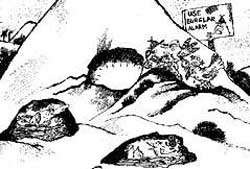Who ate my house?
 rampant harvesting of nests has caused a decline in the populations of the Edible-nest Swiftlet ( Collocalia fuciphagia ), according to R Sankaran, scientist in the division of ecology at the Salim Ali Centre for Ornithology and Natural History ( sacon ) in Coimbatore, Tamil Nadu. Sankaran has undertaken a study to assess the impact of nest collection on the swiftlet's population. In India, the bird is found only in the Andaman and Nicobar Islands. Its nests are edible, and one of the most expensive animal products in the world. The species is not included in the Convention on International Trade in Endangered Species of Wild Fauna and Flora ( cites ). This means that international trade in its nests cannot be checked easily.
rampant harvesting of nests has caused a decline in the populations of the Edible-nest Swiftlet ( Collocalia fuciphagia ), according to R Sankaran, scientist in the division of ecology at the Salim Ali Centre for Ornithology and Natural History ( sacon ) in Coimbatore, Tamil Nadu. Sankaran has undertaken a study to assess the impact of nest collection on the swiftlet's population. In India, the bird is found only in the Andaman and Nicobar Islands. Its nests are edible, and one of the most expensive animal products in the world. The species is not included in the Convention on International Trade in Endangered Species of Wild Fauna and Flora ( cites ). This means that international trade in its nests cannot be checked easily.
The nest of the swiftlet is a delicacy that dates back to antiquity. It gained commercial importance in the 16th century, when the Chinese began to value the culinary delicacy of the bird's nest soup. The demand has grown steadily, and the swiftlet has suffered
Related Content
- Judgment of the National Green Tribunal regarding sewage discharge into storm water drains which meet river Yamuna, 21/11/2024
- Judgment of the Supreme Court regarding buildings or structures demolished illegally or arbitrarily by the authorities, November 13, 2024
- Reply by Lucknow Development Authority regarding conservation and management of groundwater in Lucknow, Uttar Pradesh, 25/10/2024
- A comparison of the life-cycle greenhouse gas emissions from combustion and electric heavy-duty vehicles in India
- Order of the National Green Tribunal regarding a housing colony situated in Hindon flood plain, Uttar Pradesh, 06/05/2024
- Climate watch country greenhouse gas emissions data and methodology
